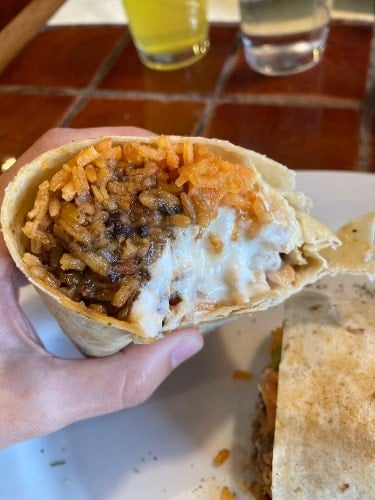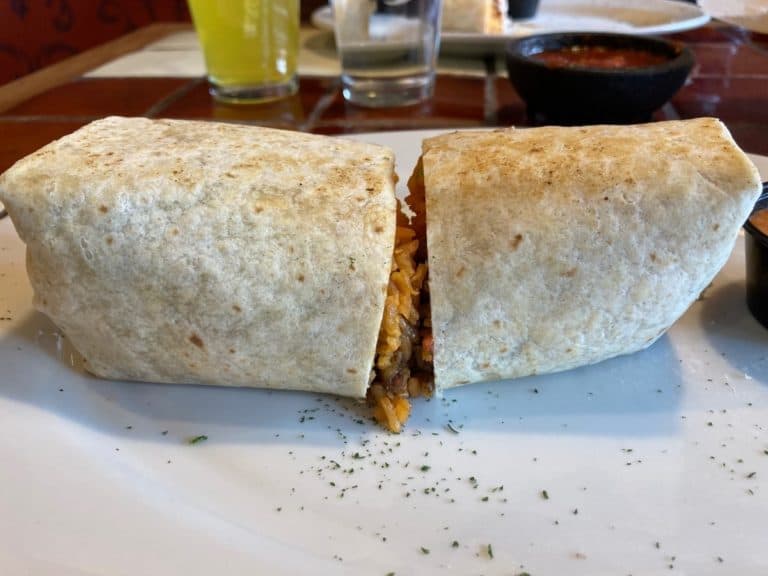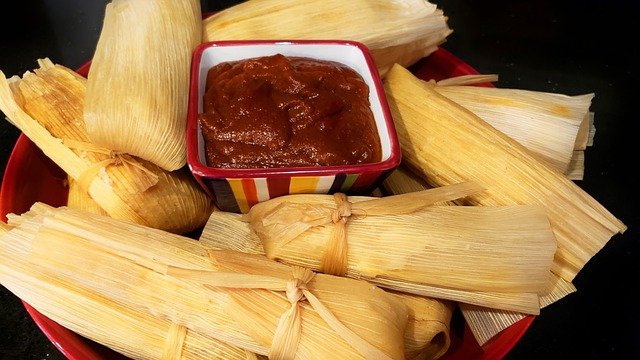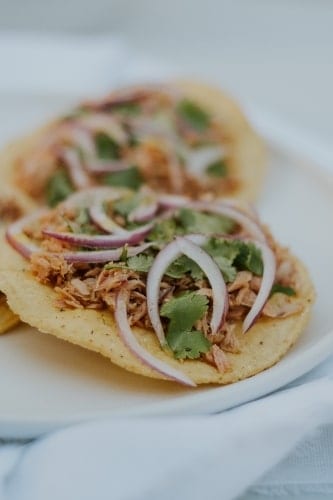How to Make Fresh Burritos From Home
There is nothing like eating homemade fresh burritos. I’m telling you, I’ve tried plenty of those microwaveable burritos you get in the freezer aisle of your local grocery store or the frozen burritos you get from the gas station right before filling up your gas tank. No. These are not good. At the moment they may be good, but they’re definitely not as great as a fresh burrito. I ain’t lying! 😉
The good thing about burritos is that you can make them any way you want! You can make them healthy or unhealthy and you can even construct them in such a way to fulfill basically any dietary need. Yes, you can even make keto-friendly burritos, too!
Before we dive into answering how to make fresh burritos in your kitchen, let’s start out by answering what is a burrito?
Read further for more information.
There are affiliate links in this post. Read my disclosure policy to learn more.
What Is A Burrito?
There is back and forth chatter about whether burritos originated in Mexico. Either way, when you think of burritos, you think of Mexico, am I right?
A burrito consists of a large flour tortilla with meat or beans and other ingredients rolled and wrapped up tightly inside of the tortilla.
You can eat burritos in one of two ways: wet or dry.
Dry burritos are often eaten by hand, while smothered wet burritos are eaten on a plate and with a fork and knife. The wet sauce is normally a flavorful red or green sauce.
These are the ingredients that can be found inside a typical Mexican burrito:
- Meat (normally beef, chicken, or pork)
- Cheese
- Beans (whole or refried)
Origins of the Burrito
The literal meaning of burrito in English is “little donkey” (a burro is a regular-sized donkey).
The origins of the burrito are super unclear. However, many people believe that the burrito came into existence after the taco.
People believe the word “burrito” comes from the fact that donkeys used to carry food from one place to another. Similarly, the way the burrito is made and packaged together (encased inside a flour tortilla) makes carrying food from one place to another a lot easier.
There is also a legend out there that the term “burrito” originated from an old man calling kids his little burritos, which meant (in colloquial terms) little dumb ones.
[You can find out more about this story HERE].
What Is the Difference Between a Taco and a Burrito?
The biggest difference between a burrito and a taco is that the food in a burrito is completely enclosed whereas the food inside a taco is exposed.
Also, a burrito by itself can normally be a full meal. On the other hand, you normally need to eat more than one taco to feel content. My husband, for example, needs to eat about 5 street tacos to feel the slightest bit satisfied.
The reason for this is that street tacos are smaller in size than regular tacos. You’ll normally have to eat several street tacos to feel full (a small kid can possibly eat one street taco and be content).
Oh. Whoops. What is a street taco?
They’re tacos that are normally served on the street (or on the side of a road). Like I mentioned before, they’re small in size and are served on one or two corn tortillas. Street tacos are filled with chopped or shredded meat (normally beef, chicken, or pork), diced onions, diced cilantro, juice from fresh lime, and a tad bit of hot salsa to top it off.
Also, the ingredients used for tacos are generally lighter compared to ingredients used for burritos. Burritos are larger and stronger than tacos, so they can hold more dense foods such as rice and beans.
Lastly, burritos can be filled with different kinds of proteins (meat as well as beans, for example) whereas tacos are normally served with only one kind of protein.
Interesting Facts About Burritos
Here are some interesting facts about burritos that you may or may not have heard before:
- California native (Riverside – Whoop whoop), Duane Roberts, invented the frozen burrito. His dad sold meat patties to the original McDonalds restaurant in San Bernardino, CA (whoop whoop)!
- The earliest mention of burrito was in the Diccionario de Mexicanismos in 1895.
- The earliest mention of burrito in the United States was in the Los Angeles Times newspaper in 1958.
- Earlier versions of the burrito were plain compared to the ones we see in the United States today.
- A wet burrito is smothered in a red or green sauce similar to enchilada sauce.
- The big burritos we see today all over the United States are reminiscent of the original Mission Burritos which were made popular in the Mission district of San Francisco, California around the 1960s. (So, the burrito that comes to mind for many of us today is actually a California concept. Who would have thunk)!
- A breakfast burrito variation often consists of scrambled eggs, sausage or bacon, potatoes, and cheese.
- The California burrito (MY FAVORITE) was developed in the 1980s in San Diego, CA and it consists of french fries (YUM) and cheese in addition to other ingredients.
- A chimichanga is a deep-fried burrito.
- The carne asada burrito is another California favorite. It includes carne asada meat, guacamole, pico de gallo, among other ingredients.
What Makes an Authentic Burrito?
So, what makes an authentic burrito, you may ask?
Well, let me start off by saying that the burritos we eat today are a whole lot larger than what was made in the early days.
A typical Mexican burrito was smaller and thinner in size and normally filled with meat, beans, and cheese.
That’s it.
Today, at least here in the United States, we can go to a Mexican restaurant and order burritos that we have to hold with two hands because of the amount and size of the additional ingredients (yummy ingredients) that are included.
These additional ingredients may include any (or all) of the following:
- Mexican-style rice (made from a tomato base)
- Pico de gallo (tomatoes, onions, cilantro, lime juice)
- Cream
- Salsa
- Guacamole
- Shredded cheese
What Makes Ingredients Fresh for Fresh Burritos?
Food is considered fresh when it has not been preserved.
In other words, it hasn’t been frozen and ingredients that preserve (such as salt) have not been added.
]It’s important to note that fresh ingredients do not typically last as long as those that have been preserved. For this reason, if it is available, it is important to check the “best by” and “use by” dates that are on the label of the products you buy].
There are some great benefits to using fresh ingredients!
For example, fresh ingredients are that they are generally healthier (less chemically processed), contain more nutrients, and generally taste a whole lot better (Washington Post).
How to Keep Your Ingredients Fresh
So, in order to make fresh burritos, of course, you’re going to need fresh ingredients!
Here are some facts about how to keep ingredients fresh for your fresh burritos.
Vegetables
You’ll most likely be using fresh cilantro, cabbage, lettuce, and/or onions in your fresh burritos, so listen up! (Er… I mean read further, haha)
OK, so the first step in keeping your vegetables fresh is to purchase fresh vegetables!
For example, you need to make sure that your cilantro or other leafy greens are bright and that they do not have any yellow discoloration or limpness.
Also, when selecting onions and cabbage, it’s a good idea to weigh them in your hand and see if they seem heavier than their size (they should be). Also, make sure there are no visible dark or soft spots.
As far as storing your vegetables, most vegetables do very well in cooler temperatures (AKA your refrigerator).
However, it is recommended that onions and garlic (and potatoes if you are using them) be stored away at room temperature.
[So, outside your refrigerator].
Also, if the vegetables you bought do better at room temperature, like onions, garlic, and potatoes, make sure to discard the plastic bags they came in.
The reason for this is that leaving your vegetables in an environment that does not allow for adequate air circulation will result in premature spoilage.
This is not good!
Also, keep the vegetables that do better in cooler temperatures in a tightly sealed ziplock bag or container. This will allow the vegetables to retain moisture, thus keeping them fresh longer.
*On a side note, I have found that wrapping washed vegetables in a paper towel and putting them in a gallon-sized zip-lock bag makes them last a whole lot longer than leaving them as is.
I’m not quite sure why that is (perhaps it has to do with moisture) but it works!
You should try it!
For further information on how to keep vegetables fresh, you can click here.
Fresh Meat
How to make sure your meat is fresh?
The freshest meat is often straight from the butcher (and a lot of times it’s higher quality, too).
Also, you’ve got to use your senses: sight, smell, and touch.
Sight
See that the color on the meat is bright.
Beef: Bright red color (although if it’s been sealed, it may be a dark purple-red (has to do with oxygen – this is OK).
Pork: Pinkish-red color. Fat should be white with no dark spots.
Chicken and turkey: Should be pink (not gray).
Also, make sure the packaging does not have a lot of liquid, which means that the meat is no longer fresh.
Smell
Meat should not have an odor!
MAKE SURE, MAKE SURE to smell it!
[This is something I often forget to do].
Oops!!
Touch
Your meat should be firm to the touch. Make sure it doesn’t spring back or sink in.
Other Information About Meat
When shopping at a grocery store, make sure to buy the refrigerated items (meat) last. Also, try to get back into refrigeration or freezer as soon as possible!
Also, CHECK THE DATES! It’s a good idea to use meat sooner rather than later.
How to store fresh meat: keep it tightly wrapped to keep it from being exposed to air (this is why butcher paper is so great).
If you want to freeze store-bought meat, take it out of its packaging and wrap it more tightly in plastic wrap and then place it in a Ziploc bag.
Although meat can be frozen for up to a year, it’s best to use it within a few months if you want it to be fresh.
Also, if you’ve only used half of the meat, make sure to wrap up the unused portion tightly in plastic wrap.
[According to the FDA, meat should be kept in a refrigerator set to below 40 degrees (FDA.gov)].
*One other very important note: DO NOT re-freeze the meat if you want to keep it fresh!*
This is a no-no because the quality and texture of the meat will deteriorate. This means it won’t taste fresh anymore. You can’t make fresh burritos like this!
Spices and Seasonings for Burrito Meat
The spices and seasonings you’ll use to season your meats are another thing you’ll want to make sure you keep fresh. That way, your food tastes better!
The best way to keep spices fresh is to keep them tightly covered and to store them somewhere cool and dry. Thus, you will want to keep them away from heat.
[In other words, do not store spices anywhere near your stove. Inside a cabinet is a great place to keep spices nice and cool and dry].
Also, you’ll want to keep spices out of light. The reason for this is that light can discolor your spices [no bueno].
In addition, be mindful of the time from when you first open the spice container to when you are using the spice.
The reason for this is that ground spices only stay fresh for 6 months to a year! Whole spices, on the other hand, can stay fresh for an entire 2 years!
Another tip for keeping your spices fresh is to buy whole spices! This is because ground spices have been exposed to air while in the grinding process. Whole spices, on the other hand, have not been exposed to air, so they stay fresh longer.
[I personally notice this difference with black pepper. I LOVE the taste of freshly ground peppercorns compared to already ground pepper. If you haven’t tried this, you definitely have to and you’ll notice the difference! (I just use the one they sell at Aldi)].
You can click here if you’d like more information on how to keep spices fresh.
Popular Seasonings and Spices for meat in Mexican Cuisine
Some popular spices for your meat that are common in Mexican food include the following:
- Mexican oregano
- Cumin
- Coriander
- Paprika
- Chipotle chili powder
- Epazote (Sorry, this isn’t fresh, but it is a very common ingredient in Mexican cuisine. Make sure to read the comments to find out how to use it. A lot of people recommend grinding it up).
Tortillas
Fresh tortillas are SO MUCH BETTER than the store-bought ones!
If possible, I recommend that you buy fresh tortillas from the Mexican market!
They’re normally kept separate from the ones found in the aisle where they sell tortillas. For example, the fresh ones I’ve found at the last Mexican store I went to were located near where the butcher sells fresh meat.
If you’re in California, Arizona, or Nevada, I highly, highly recommend the Mexican store called Cardenas. [There’s a place on the website where you can search for the location nearest you].
Also, although not as large as Cardenas, if you’re in the Pittsburgh or greater Pittsburgh area in Pennsylvania, I recommend going to a Mexican grocery store called Las Palmas (they have various locations).
Another great option for fresh tortillas is to MAKE YOUR OWN!
Isabel Eats is one of my favorite Mexican food bloggers and she has an EXCELLENT recipe for how to make fresh flour tortillas.
[Just keep in mind that making burritos will require you to make large flour tortillas].
Salsa and Guacamole
Also, rather than buying guacamole and salsa, you can make a fresh burrito by making your own guacamole and salsa!
You’ll most likely need a blender or food processor to make salsa, but that is not necessary for guacamole.
Here is an easy recipe for easy guacamole by The Endless Meal. It only requires 3 avocados, 1 lime, garlic, and salt.
SO simple 🙂
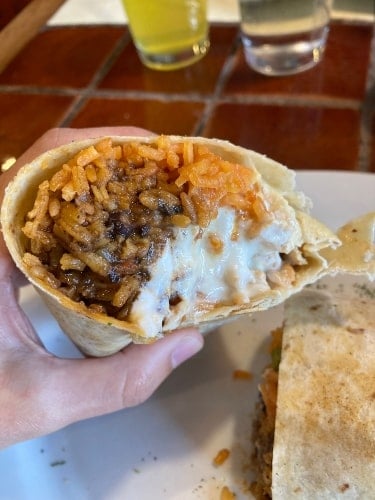
Types of Mexican Meat for Tacos and Burritos
You’ll be SHOCKED to find out how many different types of meat you can use to make (or order) your Mexican burrito or taco.
[Well, that is if you order a burrito or taco from an authentic Mexican restaurant, which I know can be hard to find in some parts of the country and the world].
However, if you live in or visit an area where they sell authentic Mexican meat (like at a Mexican meat market or butcher shop – a carnicería), here’s a list to help you out a little bit.
(On a side note… when I lived in Southern California I didn’t know what half of these different kinds of meat were. Unfortunately, I was too shy to use my Spanish, so I would just order carne asada or carnitas or chicken).
Don’t do that if you don’t have to!
Here’s a list to help you out so you don’t have to feel shy like me when you order meat from a Mexican butcher, meat market, or restaurant, lol).
These are very common meats:
- Carne Asada – Grilled seasoned beef
- Carnitas – Roasted pork
- Barbacoa – Shredded beef
- Pollo – Chicken
- Al Pastor – Pork that’s marinated and cooked on a vertical spit
- Adobada – Marinated pork cooked on a grill
- Chorizo – Specially seasoned sausage
These meats are less common, but are very common if you go to an authentic Mexican carnicería or restaurant:
- Tripa – Beef tripe (intestines)
- Buche – Pig stomach
- Lengua – Beef tongue (yes… you actually see these displayed in the display case)
- Cabeza – Cow head
- Birria – Goat
- Pierna – Pork shank (leg)
My Personal Recommendation for Buying Mexican Meat
If you have a carnicería near you, I recommend you buy your meat from there since there is a better chance for fresh meat, thus fresher burritos.
Also, if you want a more typical Mexican burrito flavor, I recommend you buy your meat from a Mexican market where the meat is already seasoned for you! (Makes things so much simpler).
However, the only downside is that you may not know what seasonings are on it, but it definitely makes things more convenient (and I’m guessing you’ll most likely LOVE the flavor anyway since the meat will still be fresh).
How to Make Fresh Burritos in Your Kitchen
So, as mentioned above, in order to make fresh burritos you will need to have fresh ingredients.
Aside from that, you’ll also need to decide the following:
- What do you want as your protein base?
- How do you want to season your protein? (I recommend fresh seasonings for really good flavor).
- Which vegetables do you want to include? (I recommend pico de gallo or even lettuce or sauteed bell peppers)
- Do you want to include rice?
- Do you want shredded cheese? Mexican cheese? No cheese?
- What sauces do you want to use (such as salsa, guacamole, cream, or hot sauce)?
After your meats and vegetables are cooked, you’ll then place all of these ingredients on your large flour tortilla and roll it up to eat.
Oh! That’s another issue!
How do you roll, form, or wrap a burrito?
Well, I’ve found an excellent video below to demonstrate just how to do this. Take a look!
[How to Wrap a Fresh Burrito]
Popular Burrito Recipes
- Here is a typical chicken burrito recipe by Dinner then Dessert that you can easily adjust to make fresh burritos (use fresh ingredients instead of canned).
- Click here for a typical carnitas (pork) burrito recipe by Spoon Fork Bacon (again, use fresh ingredients to make this a fresh burrito).
- Here is a good copycat barbacoa (shredded beef) recipe by Mexican Please.
Other Different Burrito Variations
Now that you know how to make and assemble typical burritos, read further to find out about other types of burritos you may want to try!
[Again, these are NOT typical Mexican burrito recipes, but they’re worth trying nonetheless].
Chile Verde Burritos
Ok, so chile verde literally translates to green chile.
What are chile verde burritos? Honestly, I had never heard of them until recently.
Chile verde is a type of sauce that is very popular in Mexican cuisine. It’s made primarily of tomatillos (they look like green tomatoes) and green chili peppers.
Here’s a video to give you a better idea:
[How to Make Chile Verde Burritos]
Cheeseburger Burritos
Haha! Ok, so this either sounds really yummy to you or really gross.
Cheeseburger burritos basically consist of ground beef and cheese in a tortilla. Of course, there are some seasonings and condiments in there, too.
If you choose to make this recipe, make sure to buy fresh ingredients to make it a TAD BIT (only a tad bit, haha) healthier for you.
Take a look at the video below for a visual representation of the cheeseburger burrito.
On a side note, can you guys tell what he could have done with the tortilla to make it look more like a burrito?
[How to Make Cheeseburger Burritos]
Typical California Burritos
OK, so I had these A LOT when I lived in California! I highly, highly recommend them!
They’re filled with french fries!!!
Oh, and I’ve got a GREAT idea. Why not try to make fresh burritos by using fresh-cut french fries? That would taste SO WONDERFUL!! I can picture it now!!
(Like In-n-Out fries… I miss those).
Here’s a GREAT video of how to make fresh California burritos (yes, with french fries)!
[How to Make Cali-style Burritos]
FAQs
Here are some frequently asked questions that some of you may be asking.
How many different types of burritos are there?
There are SO many different types of burritos out there and there are new kinds that are coming out every day.
[Have you ever had a sushi burrito]?
These are some popular burritos that are not too difficult to make at home:
- Chicken burrito
- Carne asada burrito
- Carnitas burrito
- Barbacoa burrito
- Breakfast burrito
What can I serve with a burrito?
A burrito is a whole meal in and of itself. However, if you’d like to add a side, you can serve the following if they’re not already included inside the burrito:
- Mexican rice
- Esquites (Mexican corn salad)
- Refried beans
- Chips and salsa
- Chips and guacamole
What toppings go on a burrito?
In all my years living in southern California, which has a huge Mexican and Mexican American population, I have never seen toppings on a dry burrito other than some cream, lettuce, maybe some guacamole, or salsa, and chopped tomatoes.
Most of the time, though, dry burritos don’t have any toppings from what I’ve personally experienced.
However, this could be because most of the time you eat dry burritos with your hands unless you order them from a sit-down restaurant.
Wet burritos, on the other hand, do have an enchilada-like sauce that is first spread on top and runs down the sides eventually smothering the burrito.
Final Thoughts on Fresh Burritos
In summary, to make fresh burritos in your kitchen, you’ll need fresh ingredients! I have provided several ways to keep your meats, vegetables, and spices fresh including how to make sure you are buying the freshest ingredients at the grocery store.
Also, I hope you enjoy the different burrito variations I have provided!
Did you learn anything new about burritos today? I’d love to hear your thoughts!
Related Posts
- Delicious Cinco de Mayo Menu Ideas for Your Next Fiesta (Party)
- Your Guide to Mouth-Watering Mexican Birria Quesadillas
- How to Eat Mexican Tostadas
- Instant Pot Tamales Recipes
- All About Burritos
- Your Guide For Amazing Mexican Sweet Bread
